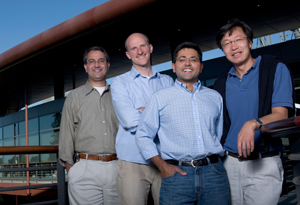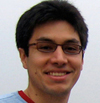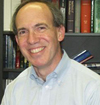September 23, 2009 - By Tracie White

Stanford's 2009 NIH Pioneer Award winners are (from left): Krishna Shenoy, Markus Covert, Ajay Chawla and Chang-Zheng Chen. Stanford has received 15 of the 81 Pioneer Awards bestowed by the agency since 2004.
Scientists at Stanford University’s School of Medicine and School of Engineering have earned 13 of the National Institutes of Health prizes intended to encourage “out-of-the-box,” high-stakes research that carries much risk of failure, but offers the potential for huge benefits if successful.
Stanford faculty will be attempting to grow a human intestine, to identify hormones in the placenta that influence brain development and to determine whether the lack of infections at an early age are the cause of the childhood obesity epidemic, among other projects.
The NIH announced on Sept. 24 the 115 recipients of its 2009 Pioneer Awards, New Innovator Awards and Transformative R01 Awards. Roughly one of every 10 went to a Stanford researcher, for an estimated $29 million over the next five years that will enable them to go for broke with their creative research proposals.
“The continued success of Stanford faculty in receiving NIH Pioneer Awards and New Innovator Awards is truly extraordinary,” said medical school Dean Philip Pizzo, MD, adding that he attributes it to “a combination of recruiting exceptionally talented individuals, providing them resources to get their research careers started, and immersing them in a community of broad and deep excellence where they and their colleagues are willing to ask big questions and pursue innovative ideas and interdisciplinary interactions that ultimately move science and medicine forward.”
James Plummer, PhD, dean of the School of Engineering, said the awards to members of his faculty underscore how scientific disciplines are evolving. “The life sciences are becoming foundational sciences for all engineers much as physics and chemistry have been for the past century,” he said. “NIH is becoming an important partner for us as a result. Engineering faculty and students have the opportunity, working with others at Stanford, to dramatically improve human health in the future.”
The NIH will be giving an estimated $348 million to the recipients over the next five years in the three award categories.
Pioneer Award winners: Four Stanford researchers are among the 18 Pioneer Awards winners this year. Each will receive grants of $2.5 million over five years. This award is for proposals that have the potential to produce a major change in biomedical or behavioral research. It must involve ideas that have not been the basis for previous research in the investigator’s lab or elsewhere. Since the program began in 2004, Stanford has received 15 Pioneer Awards out of a total of 81.
Krishna Shenoy, PhD, associate professor of electrical engineering, leads a group that studies how the brain prepares and guides arm movements. The researchers then design “brain-machine interfaces” that directly translate brain signals to control prosthetics. Shenoy said his Pioneer Award will launch an effort to understand movement in natural, real-world contexts. “We hope this will result in accelerated progress both in basic systems neuroscience and in neural prosthetic system design and clinical translation,” he said.
Markus Covert, PhD, assistant professor of bioengineering, builds computational simulations of biological systems to help guide experiments. He’ll use his award funding to build a computer model of a yeast cell that accounts for every gene. One application of the model will be to analyze how dietary restriction affects lifespan not only in yeast, but also in mammals. “It would be impossible to do this kind of work without Pioneer funding, even given its critical importance,” Covert said. “It’s just too high risk.”
Ajay Chawla, MD, PhD, assistant professor of endocrinology, will explore the basic biological mechanisms necessary for tissue regeneration in mammals. Past studies have suggested that activation of the immune system is the critical trigger of tissue regeneration, but the exact pathways aren’t known. His proposal is to determine whether an immune pathway is the “master orchestrator” of tissue regeneration. The ultimate goal of the research is to come to a better understanding of the aging process, and how to slow it down.
Chang-Zheng Chen, PhD, assistant professor of microbiology and immunology and member of the Baxter Laboratory in Genetic Pharmacology, focuses on the functions of microRNAs––roughly 22-nucleotide-long, single-stranded RNA molecules that regulate gene expression. The recent discovery of microRNA revealed a novel paradigm of gene regulation and expression, creating a new field of medical research. Chen has identified regulatory information residing in sections excised from the 22-nucleotide-long strips that constitute the mature miRNA molecule. He plans to use his award to elucidate the mechanisms by which these excised elements unexpectedly control the biological activity of microRNA genes.
New Innovator Award winners: Five of this year’s 52 New Innovator Awards were given to Stanford researchers. They will each receive $1.5 million over five years. This award is designed to support unusually creative investigators at an early stage of their career. This brings to eight the number of New Innovator Awards for Stanford.

Euan Ashley
Euan Ashley, MD, PhD, assistant professor of cardiovascular medicine, will use the award money to investigate treatment strategies for the genetic cause of hypertrophic cardiomyopathy, an inherited condition that causes a thickening of the heart muscle and is the most common cause of sudden death in young people and athletes. “For many years, we have become better at describing what causes hypertrophic cardiomyopathy, but our therapies have remained rather palliative,” Ashley said. By investigating the use of RNA silencing to “turn down the volume” of the genetic mutations that cause the disease, Ashley hopes, for the first time, to treat the root cause of the condition.

Sarah Heilshorn
Sarah Heilshorn, PhD, assistant professor of materials science and engineering, creates three-dimensional gel cultures that mimic the environment of the body to study the development of stem cells into new nerve tissue. Her goal is to produce regenerative medical therapies for victims of stroke and neurodegenerative disease. She said her grant will enable her lab to launch a project studying how mechanical and chemical stimuli work together to guide the movement of neural stem cells.

K.C. Huang
K.C. Huang, PhD, assistant professor of bioengineering, studies the fundamental mechanisms used by cells to detect, determine and maintain specific shapes. Bacterial cells often use their shape to regulate complex processes such as motility, division and adhesion. Huang, trained as a theoretical physicist, plans to apply his grant toward the development of synthetic tools for engineering cell shape, with potential applications in biosensing, control of pathogenic bacteria and nanomaterial design.

Anna Penn
Anna Penn, MD, PhD, assistant professor of neonatal and developmental medicine, will use her award to study the placenta’s role in regulating fetal brain development. While it has long been known that the placenta produces many hormones, their effects on the fetus are poorly understood. Penn’s funding will enable the first-ever research to directly and systematically examine the roles of key placental hormones on prenatal brain development. Her team will develop a series of genetically engineered mice in which individual hormones will be removed from the placenta at specific times in development. Penn hopes the project will lead to better treatments for premature infants, as well as deeper understanding of cognitive disorders in which placental dysfunction has been implicated, such as schizophrenia and autism.

Justin Sonnenburg
Justin Sonnenburg, PhD, assistant professor of microbiology and immunology, notes that several diseases, including obesity and inflammatory bowel disease, are known to be associated with alterations in the composition of the microbial communities that inhabit our digestive tract. Sonnenburg proposes to identify small molecules that, by perturbing the function and composition of these microbial communities, can serve as tools that can determinine the extent to which these changes are the cause or the symptoms of disease. Such compounds could have therapeutic applications as drugs that target specific types of intestine-dwelling micro-organisms.
Transformative R01 Award winners: New this year are the Transformative R01 Awards, which will support projects that have the potential to create or overturn fundamental paradigms in biomedical research. Stanford received four out of a total of 42 awards, with the funding amount varying by project. In some instances, the funding amount has not yet been finalized.

Andrew Hoffman
Andrew Hoffman, MD, professor of endocrinology at the medical school and chief of endocrinology at the Veterans Affairs Palo Alto Health Care System, plans to use his $1.8 million award to build on his previous research showing that physical interactions occur between DNA segments that are surprisingly far apart from each other. “We usually think of genes lined up on a chromosome in a very linear way,” Hoffman said. “DNA actually forms loops, and distant genes can interact with each other in this way.” He wants to study whether deletion of a given part of a chromosome can cause a disease by disrupting these long-range interactions between genes that would have otherwise occurred. He plans to test this hypothesis on a chromosome-22 deletion disorder that can cause heart defects, hypoparathyroidism and schizophrenia.

Calvin Kuo
Calvin Kuo, MD, PhD, associate professor of hematology, will use his $3.9 million to grow a three-dimensional human intestine, complete with protein scaffolding and differentiated cell types. “It’s as close a mimic to the in vivo situation as you could hope to achieve,” Kuo said of the current prototype, the first of its kind. “We’re having a lot of fun with it.” Because the intestine is involved in so many diseases, including cancer and infectious diseases, the model will be fundamental to research in many areas, he said.

Julie Parsonnet
Julie Parsonnet, MD, the George DeForest Barnett Professor in Medicine and professor of infectious diseases and of health research and policy, studies interactions between people and the micro-organisms that chronically infect them. She will use her award, estimated at $3.8 million, to explore the relationship between chronic childhood infections and weight gain in children. Noting that a dramatic increase in childhood obesity over the last four decades coincides with an equally dramatic decrease in infection rates, Parsonnet proposes several pilot studies to test the hypothesis that the absence of frequent, chronic and/or severe prenatal and childhood infection is a significant contributor to weight gain in children.

Joseph Wu
Joseph Wu, MD, PhD, assistant professor of medicine and of radiology, will use his estimated $2 million award to investigate ways to keep the body from rejecting human embryonic stem cells. For many years, researchers assumed that these undifferentiated building blocks would be ignored by the body’s defense system. Wu’s recent research in mice shows that this is not the case. “It’s getting harder and harder to believe that these cells are immunoprivileged,” said Wu. “Now we need to know what to do about it.” He’ll use his award to devise ways to coax the immune system to tolerate the foreign cells, allowing them to regenerate or heal damaged tissues.
Writers Krista Conger, Erin Digitale, Bruce Goldman, David Orenstein, Ruthann Richter and Tracie White contributed to this report.
About Stanford Medicine
Stanford Medicine is an integrated academic health system comprising the Stanford School of Medicine and adult and pediatric health care delivery systems. Together, they harness the full potential of biomedicine through collaborative research, education and clinical care for patients. For more information, please visit med.stanford.edu.